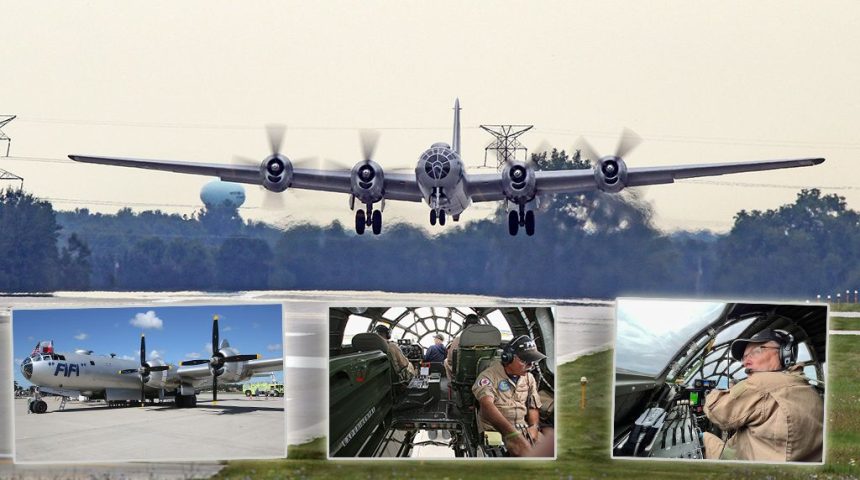Living the Legacy of One of History’s Greatest Aircraft, and Its Greatest Generation.
This suddenly seems right. After two hours of never-ending Michigan road construction, I exit the main I-75 north-south freeway and am transported back seven decades. It could be mid-summer, 1944. This could be the rural landscape outside Wichita. The place where the WWII “Battle of Kansas”, the struggle to get the Boeing B-29 Superfortress ready for war, unfolded.
Bumpy black top roads bisect verdant green farms overgrown with rows of corn stalks. The crop is past “knee high by the Fourth of July”. Small farm houses stand near barns with tractors and combines. They’re silent today. It’s a rare respite from the constant trudge of seasonal dawn to dusk farm work. Farmers and families got word that something special is happening this weekend. The B-29 Superfortress is coming.
Kids are loaded into pickup truck beds. Grandfathers wearing veteran ball caps, the ones that say where they served, ride in front seats. The Boy Scouts are here. So is the local VFW chapter. Everyone from farms for miles around came out today. Even folks from out of state in big cars drove out to the little airfield just to see her.
And there she sits, right in front of us out on the bright tarmac under a vaulting blue sky. Fifi, the Boeing B-29 Superfortress. One of only two left flying in the world today. The biggest, most powerful thing these kids have ever seen.
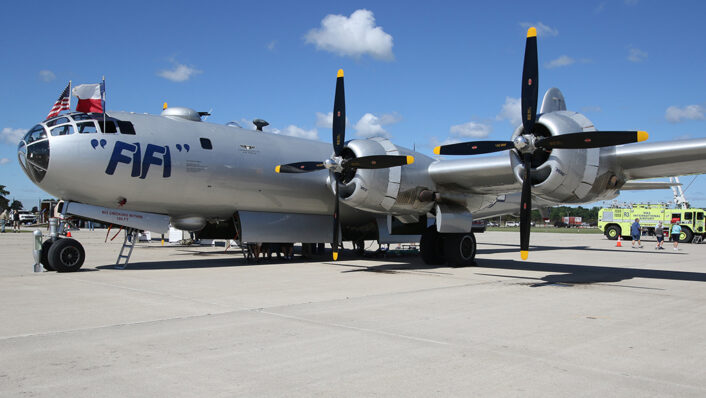
“This is the plane that won the war”, a grandfather in an Air Force ball cap tells his grandson. “She dropped the big one”.
History, they say, is written by the victors. The popular American belief that the Boeing B-29 Superfortress singlehandedly won WWII in the Pacific with its revolutionary long range and nuclear weapons is more than lore. It’s the accepted narrative from every U.S. junior high school history class to the somber monuments at Hiroshima and Nagasaki.
And while that narrative isn’t entirely accurate, today isn’t about correcting historical paradigms. It’s about experiences. Experiencing a collective human endeavour so significant that history has struggled to record it. Perhaps because the B-29’s history is so vast, and its historical implications so complex.
The Commemorative Air Force, or CAF, flies Fifi out of their home base in Fort Worth, Texas. The organization has a remarkable 181 historical aircraft flying out of 90 units based around the United States. The CAF, with 13,000 members, is a non-profit committed to the preservation of historical aircraft and, in the grander scheme, the history of air power across nearly every conflict that involved aerial combat. There are U.S. aircraft, of course. But there is also a spectacular collection of ultra-rare aircraft from countries like Germany, Japan, Britain, the former Soviet Union, North Korea and Vietnam. More so than any museum, the Commemorative Air Force (CAF) is truly keeping history alive.
The massive Boeing B-29 Superfortress, Fifi, is the gem of the CAF stable of remarkable aircraft.
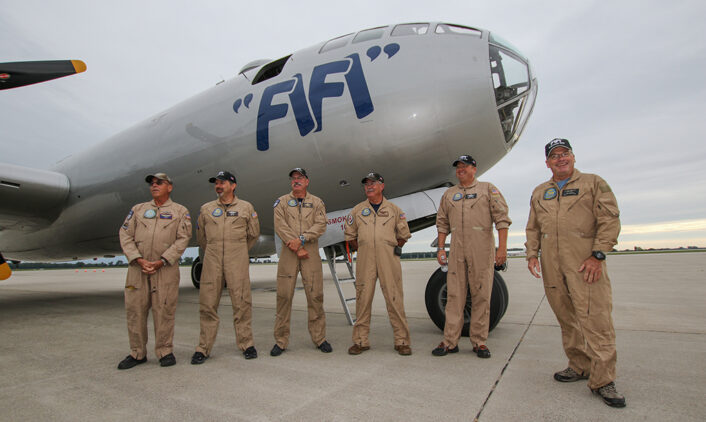
Like a few people out here today, I’ve got a personal connection to the Boeing B-29. My dad was a draftsman on the B-29 project at Boeing’s Renton Plant near Seattle in 1944 and ‘45. And while little about my dad’s life was remarkable, this, along with his later work on the first atomic powered submarine, the USS Nautilus, was the thing he talked about most. My fascination with aviation and desire to be a journalist are inspired by my dad’s work on the Boeing B-29 Superfortress. Today, along with a small group of other aircraft and history enthusiasts, I get to fly on Fifi.
The crew of CAF volunteers who administer flights on Fifi, and her sister aircraft, a Consolidated B-24 Liberator named “Diamond Lil”, run the program like a mini-airline. A group of volunteers with iPads check in excited passengers for their flight on Fifi. One of the volunteers delivers an FAA-required pre-flight briefing to our group. The information differs from a standard airline briefing:
“You can look inside the crew tunnel from the front compartment to the rear over the bomb bays, but please don’t enter the tunnel in flight. It can be very claustrophobic.” On long missions from the Marianas to Japan and back, the pressurized crew tunnel was a popular place for naps. Today that tunnel is much smaller than I pictured from reading about it. Americans were thinner then.
“If you have to exit the aircraft in an emergency, we’ll let you know…” My mind flashes back to reading about how hard it was to bail out of the B-29 in WWII. It required lowering the landing gear to open the nose wheel door, and opening a large hatch just behind the pilot and aircraft commander. Then jumping out, usually from a burning aircraft. If you were unfortunate enough to be over Japan and survive the escape, a hellish imprisonment, lynching or execution waited for you on the ground. If you were flying over the thousands of miles of vast ocean between Japan and the Marianas, you would likely just disappear without a trace. In rare instances, submarines on picket duty or modified B-29s carrying droppable life boats, or PBY Catalinas and PBM Mariners may find you. But today, we won’t need parachutes.
The volunteer giving the briefing asks, “Do any of you have a personal connection to the B-29?”. Before I can answer, I have an unexpected flood of emotion about my dad. He was mostly gone by the time I was eight. His B-29 stories were the only positive recollection I had of him. He died years after he left our family. I drove to his funeral in rural Indiana. When I spoke at his wake, the only thing I could say about his life was that he worked on the B-29 and the first nuclear submarine. I cleaned out his little cottage near the fire station in the small Indiana farm town where he died. One of the few artifacts of his life was a blueprint showing the pressurization tunnel in the B-29. In the lower right corner of the drawing was a small rectangle. Neatly printed inside the rectangle was the name, “T.DEMERLY”. His name. The same name as mine.
Connecting to the history of WWII and its profound political and social influences reveals deeply personal threads that still run through America. Letting these threads unravel over time risks losing our memory of the horrors of global conflict. And while much of experiencing Fifi is about reverence and nostalgia, it’s also about remembering loss and tragedy in the hopes of never reliving it. Losing this living history risks the many lessons of massive endeavors like the B-29 project, the most expensive human undertaking in history at the time of its completion. The B-29 was the fruit of labor from America’s “Greatest Generation”. And the B-29 changed the arc of human history. My generation has the Apollo moon landings. My dad’s generation had The Bomb and the B-29 Superfortress.
We’re onboard Fifi now. Ready for engine start. A part of me hopes for… just a little engine fire maybe. It would make the story better. But Fifi is better maintained than any commercial airliner. She gets nearly constant maintenance. I spoke to B-29 mechanic Mat Pedron. “She gets more maintenance than any other aircraft, she’s the safest airplane flying”. The four Wright R-3350 Duplex-Cyclone 18-cylinder radial engines on Fifi are heavily upgraded with PR-58 pressure injected carburetors he tells me. The persistent overheating and fires that plagued the WWII versions are gone. We’re very safe today, thanks to crew members like Mat Pedron.
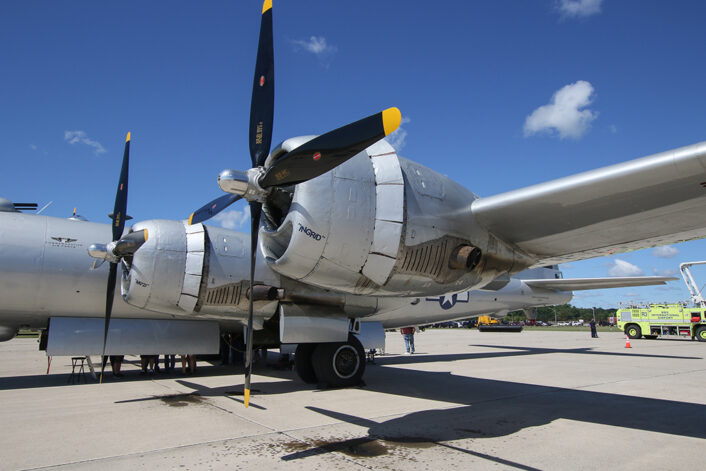
With all four engines running there is a rattle of strange and dissonant vibrations through the aircraft. The engines cough huge puffs of smoke. The noise in the cockpit makes talking impossible. Landing gear squeaks over engine roar as the brakes are released. We taxi for takeoff. For a second I close my eyes and wonder what this was like 77 years ago. When I open my eyes and glance out the flight engineer’s window next to me it looks like the entire little farm community has turned out to see us off. Kids and women wave to us. An old man in one of those hats salutes. My gut plummets and eyes flood.
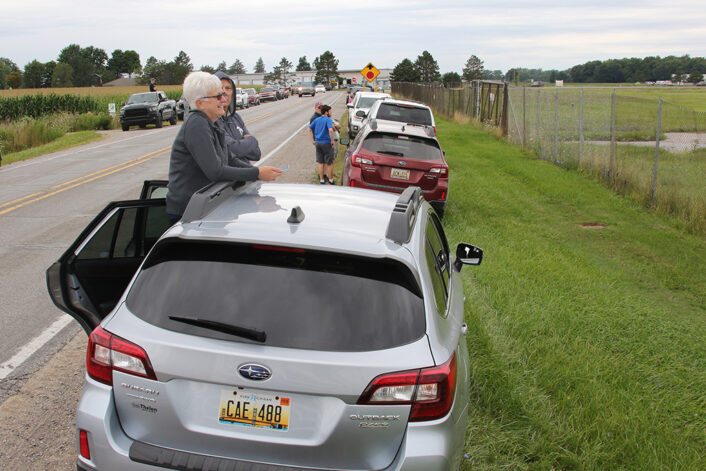
Fifi lumbers out along the taxiway and, in an unexpected bonus, we have a real escort from the P-51D Mustang, “Gunfighter”. She’ll be our fighter cover today, protecting us from the ghosts of Japanese Ki-45 Toryu and Ki-61 Hien fighter planes intent on ramming us in imaginary aerial suicide attacks as we fly out over Lake Huron pretending we’re on our way to Tokyo. If this were 1945, the threat of suicide attacks from Japanese Ki-45 Toryu and Ki-61 Hien fighter planes on our bomb run over Tokyo would be a reality.
The sounds, smells and vibrations of Fifi are very different from any other flight. They are unnerving. I remind myself that we aren’t facing a 12-14-hour flight to Japan. There will be no risk of disappearing over the vast Pacific. No flak. No Japanese ramming attacks. No aerial bombs dropped on us from above. We don’t risk fully armed “hung” bombs stuck in our bomb bay, or signal flares exploding in our cockpit- all common during B-29 raids.
The story of the B-29 raids in the Pacific in WWII hasn’t received the same attention as the air war in Europe. The elegant B-17 Flying Fortress and utilitarian B-24 Liberator heavy bombers got much more media during and since WWII. The film reference website imdb.com lists at least 27 movies that feature the B-17 Flying Fortress. But there is only one obscure Hollywood film about the B-29 raids on Japan, a quirky 1951 propaganda flick called, “The Wild Blue Yonder” directed by Allan Dwan.
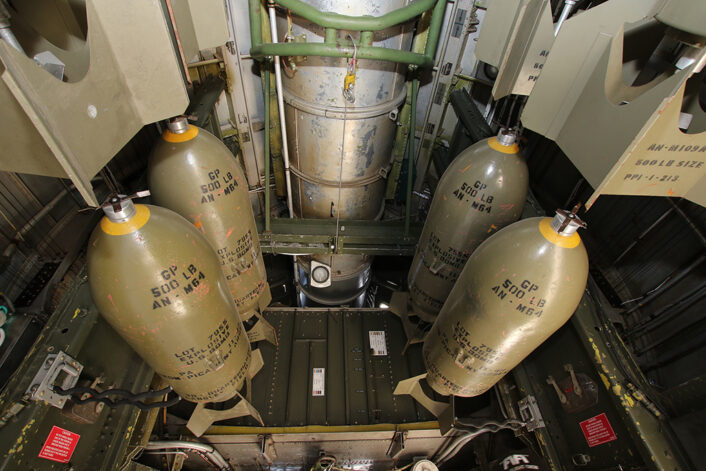
There are quite a few books about the B-29 and its campaign in the Pacific. Many of them are good, some are excellent. But in an irony typical the B-29’s history, the single best-selling book about the aircraft’s history, author Malcom Gladwell’s, “The Bomber Mafia”, is the most distorted account of the B-29 and the role of strategic bombing in WWII. Gladwell’s book, which has a baffling 7,586 reviews on Amazon and a four-and-a-half-star rating, is rife with technical inaccuracies and unrealistic revisionist history. One Fifi crew member told me that Gladwell’s book is, “The worst thing to ever happen to the B-29”. In many ways, Gladwell’s “Bomber Mafia” has done to the B-29 what Peter Benchley’s “Jaws” did to sharks. It’s skewed public perception with poor research, sensation and shallow interpretation. I bought “The Bomber Mafia” with excitement when it was released, missed its thesis on my first reading, read it a second time and decided it really had no thesis. But Gladwell’s Harvard pedigree and previous unrelated bestsellers give his B-29 narrative, erroneous and distorted as it is, brand identity. So it sells. And that’s a shame, because the real story of the B-29 in the Pacific and its influence on the trajectory of history is much more fascinating that Gladwell’s best-selling baloney.
We’re lined up on the runway now. From my seat in the flight observer’s position behind the aircraft commander I watch Col. Steve Zimmerman run the final checks. Next to him in the right seat, Col. Randall Haskin calls out the checklist. Zimmerman, on the left, would be called the pilot in any other aircraft. He will do most of the flying, supported by Col. Haskin, normally called the co-pilot. In the case of the B-29, the co-pilot is called the pilot and the pilot, Col. Zimmerman, is the aircraft commander.
Sitting to my right, flight engineer Fernando Daleccio monitors a dizzying array of round-dial engine instruments and more switches and levers than the man behind the curtain in the Wizard of Oz. He manipulates levers controlling fuel mixture to Fifi’s four huge radial engines. Suddenly the dissonant vibrations fade and Fifi settles into this magnificent, powerful roar. She steadies herself on the end of the runway, as if squatting to accelerate. I see Daleccio’s mouth moving into his intercom mic with the rest of the crew but can’t hear a word as the sound of a rising, aviation-fuel driven hurricane fills the B-29. Col. Zimmerman glances at his crew, looks over his shoulder at me, nods, and releases the brakes.
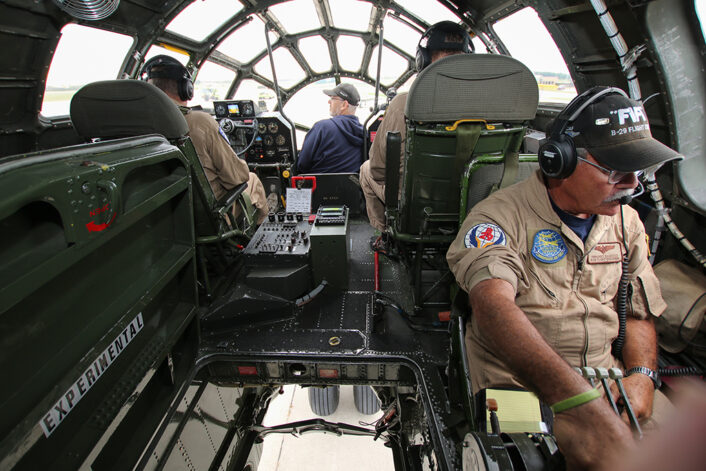
On Tinian, Saipan or Guam during WWII, takeoff was perhaps the most dangerous part of an ultra-long-range B-29 strike mission against distant Japan. The Superfortresses were all overloaded with fuel and bombs, well above the gross takeoff weight Boeing test pilots published. In a bizarre irony, an engine fire and crash over Seattle killed Boeing’s most famous B-29 test pilot, Eddie Allen, during testing in 1943. Boeing engineers knew about the problems with B-29 engine fires. But there was no time to correct it. My dad saw Allen’s crash scene in Seattle when it happened.
Superforts in long lines taking off from the Marianas in WWII used every foot of runway to lumber precariously into the air. Sometimes they didn’t make it, crashing into the ocean just off the island with a full fuel and bomb load, killing everyone one board. The next B-29 in line behind it still had to take-off. There were no safety stand-downs.
Our takeoff is completely different. Fifi, fawned over by mechanics and a few thousand pounds lighter than she would have been on a bombing mission in WWII, levitates eagerly upward half way down the runway. And we’re flying.
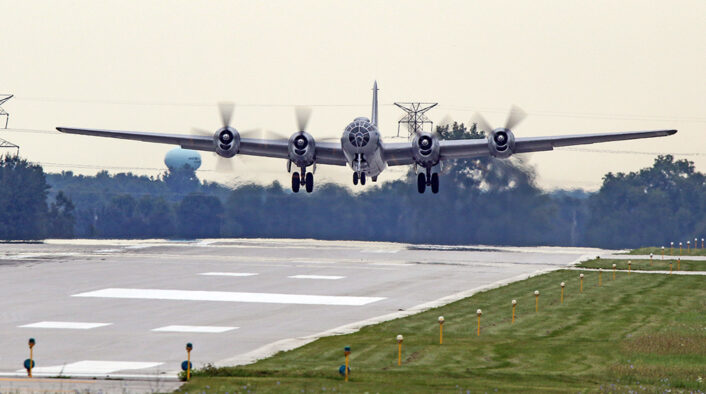
I’ve flown on a few WWII aircraft. A couple C-47s, a B-17 Flying Fortress. But nothing is like this. Flying on Fifi is power and strength and the realization of what America is capable of at her best. When we put our collective will to a massive undertaking.
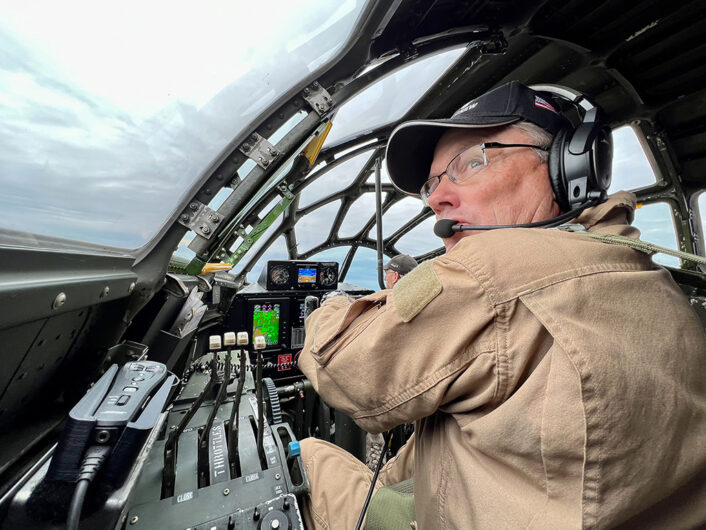
The B-29 is what happens when America’s back is against the ropes, her anger is inflamed, and we rise to a challenge. Fifi stands for America at her very best, and this experience may be more important today than at any time in our country’s history.

